MR. DINKINS’ BULGING FACADE (1977)
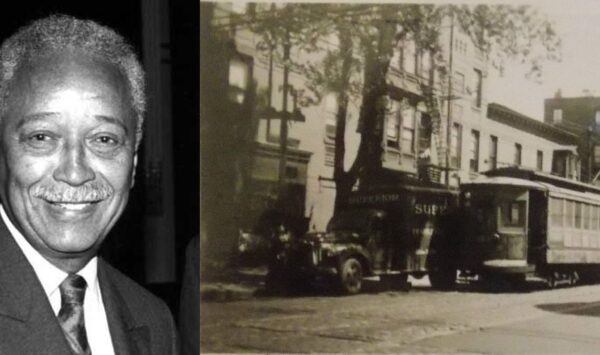
******************************************************************************************************************************** Brownstone Detectives investigates the history of our clients’ homes. The story you are about to read was composed from research conducted in the course of one of those investigations. Do you know the history of YOUR house? ******************************************************************************************************************************** Have you ever wondered what once filled those large lots at the corners of Halsey Street and Ralph Avenue? Every house has a history. You know it is there, but the clouds of the past work to obfuscate the present. Uncovering that history takes some detective work, but with a little time and some gumshoe sleuthing, the answers can be discovered. With regard to 774 Halsey Street – what do we know happened? A fire? Decay? Gas explosion? What do we know about the life of the building? What was it used for? Who owned the building and who lived there? We looked to clues from newspaper archives, fire insurance maps, and physical evidence to unravel that history. This is our report: WHAT HAPPENED to 774? A 4-story brick apartment building – 774 Halsey Street – sat on the southeast corner of the Halsey/Ralph intersection. It had a commercial space on the ground floor facing Halsey Street and one at the rear of the building at 153 Ralph Avenue. The building housed a number of apartments the addresses/entrances of which were on the Ralph side of the building at 149 Ralph Avenue. The apartments of the Ralph-facing side of the building had stacked bay windows, one on each floor. South of […]
THE VIRUS TAKES A WOMAN MARINE (1918)
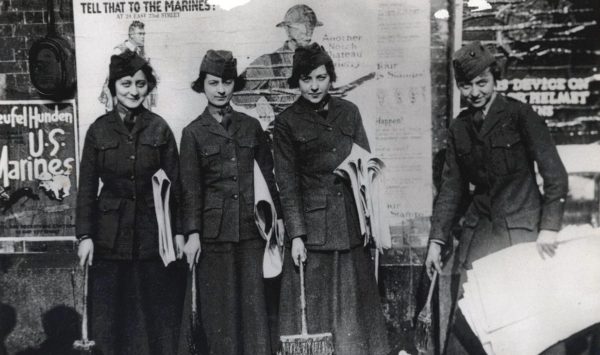
******************************************************************************************************************************** Brownstone Detectives investigates the history of our clients’ homes. The story you are about to read was composed from research conducted in the course of one of those investigations. Do you know the history of YOUR house? ******************************************************************************************************************************** In 2014, The Brownstone Detectives partnered with the New York City Parks Department to help celebrate the lives of the servicemembers of Bedford-Stuyvesant Heights who made the ultimate sacrifice during the Great War. We researched these heroes to locate pictures, stories, and their descendants to be brought together for a ceremony that dedicated a new “Victory and Peace” war memorial at Saratoga Park. This biography tells the story of one of those servicemembers. PROLOGUE In 1918, when the United States was fighting a war overseas, the country was also fighting a conflict back home – influenza. Just as people were dying in the the “Great War” to combat “the Hun,” Americans were succumbing back home to a virus that was leading to their deaths in hospitals. Much like with today’s coronavirus, there were still essential services then that needed to be continued. One of those services was recruiting for that overseas war. One of those recruiters was one of the first woman Marines. She lived on Macon Street in the Bedford-Stuyvesant section of Brooklyn. She came down with influenza while on recruiting duty in Manhattan. And she became the first woman Marine buried with full military honors. This is her story. PVT. LILLIAN MAY BOGEN PATTERSON It would be a mistake […]
“ANYTHING FER THANKSGIVING?”
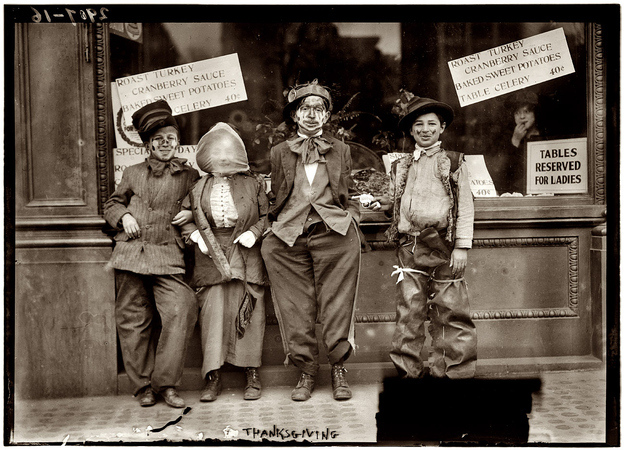
******************************************************************************************************************************** Brownstone Detectives investigates the history of our clients’ homes. The story you are about to read was composed from research conducted in the course of one of those investigations. Do you know the history of YOUR house? ******************************************************************************************************************************** Before there was Halloween “trick-or-treating” – there was another tradition in Brooklyn: Thanksgiving “begging.” A STORY ABOUT CHILDREN PANHANDLING IN BROOKLYN Most people have never heard of this custom, but that is because it ended sometime in the 1940s or 1950s here in the northeastern part of the U.S. But in the process of doing research on a brownstone for a Brownstone Detectives House History Book, we tracked down a former resident who, during her interview, and to our great surprise, began telling us about this defunct holiday. “In the morning we were dressed up as hobos, in whatever old clothes our parents gave us,” said Patricia O’Neill who used to live at 738 Macon Street in the eastern section of Bedford-Stuyvesant, “and we went from door to door saying, ‘Anything for Thanksgiving?’ “They used to give us a dime or an apple.” O’Neill (Loftus at the time) remembers the custom well. Where she grew up in Bedford-Stuyvesant, all of the kids dressed as hobos and they spent the morning of Thanksgiving Day carousing the neighborhood “begging” for food and money from their neighbors. THE HISTORY The custom which started around 1870 may have a connection to Martinmas, the feast day of St. Martin of Tours, patron saint of beggars and […]
“SHAKESPEARE’S GHOST” AT 437 HALSEY (1889)
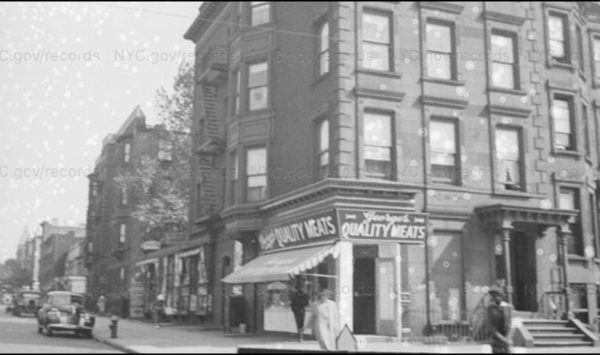
******************************************************************************************************************************** Brownstone Detectives investigates the history of our clients’ homes. The story you are about to read was composed from research conducted in the course of one of those investigations. Do you know the history of YOUR house? ******************************************************************************************************************************** The Brownstone Detectives investigates the histories of our clients’ old houses. In the process, we have come across no small number of incredibly juicy stories featuring the houses and their lineage of occupants. Every once in a while, those stories – as stories sometimes do – feature a topic we rarely wade into – the paranormal. While most properties we investigate do not involve the supernatural, it is even rarer still to find an old brownstone that comes with a thoroughly debunked ghost story. No. 437 Halsey Street – in the Bedford Stuyvesant section of Brooklyn – is one of those houses… ***************************************************************************************************** In late 1889, during a strong snowstorm in the City of Brooklyn, word began to get around about the “haunting” of an apartment house at the corner of Halsey Street and Lewis Avenue, along with its complement of frightened and fleeing former residents… “…the snow was blowing everybody in doors yesterday,” started the Brooklyn Daily Eagle, setting the scene for its readers of “an ambitious little ghost story-started out on its career of making trouble. The “trouble” mentioned in this story was the reaction that the rumor of ghosts in the apartment house had engendered. It brought to the sole remaining occupant of the structure a whole host […]
WHEN SARATOGA AVENUE WAS YOUNG (1899)
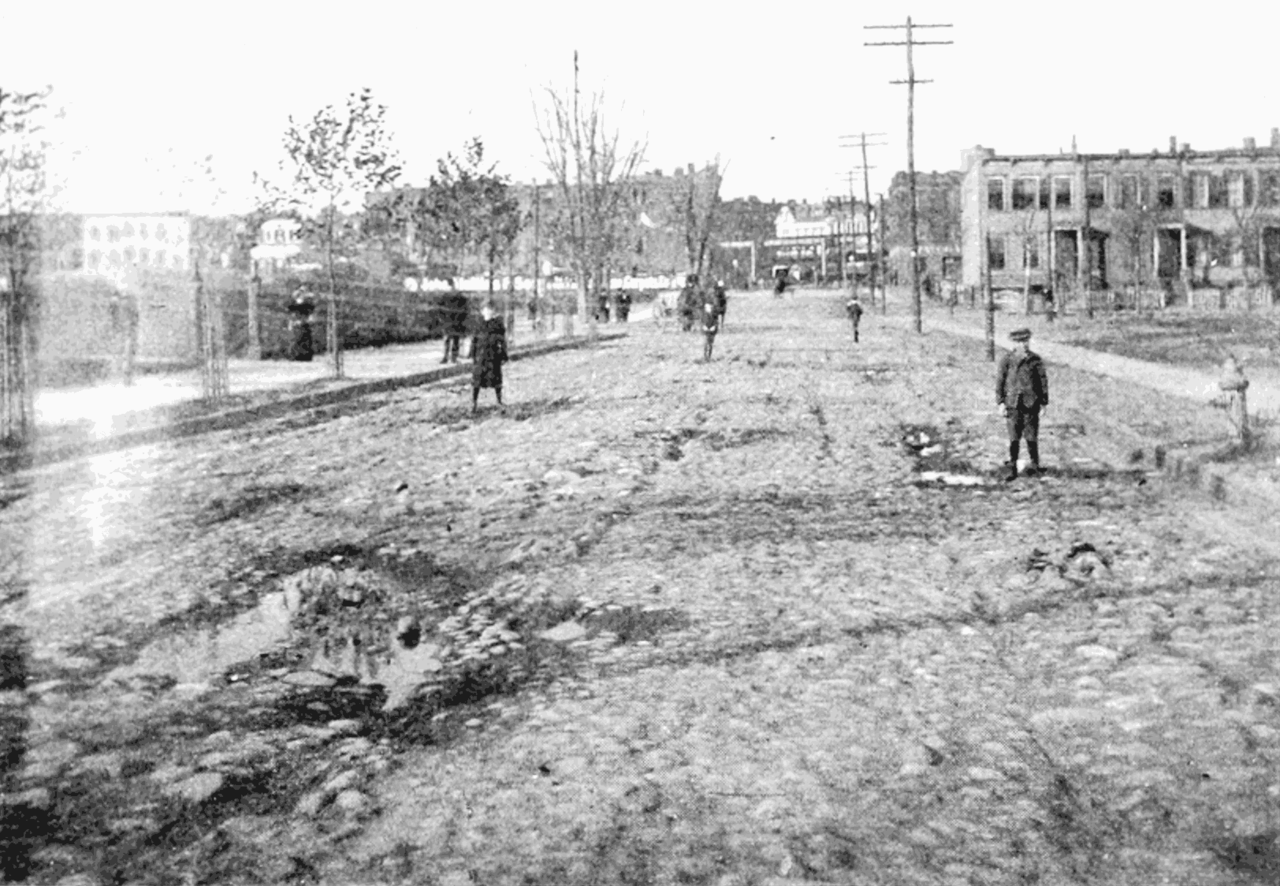
******************************************************************************************************************************** Brownstone Detectives investigates the history of our clients’ homes. The story you are about to read was composed from research conducted in the course of one of those investigations. Do you know the history of YOUR house? ******************************************************************************************************************************** We’d never seen this 1899 picture before – the cobblestones of Saratoga Avenue – taken from Macon Street looking north. To the left you see the gates of the 3-year old Saratoga Square Park and to the right, what was known then as Saratoga Field. A few years before this shot was taken, you would have seen the circus and the various Wild West shows of the time camping out on these two blocks, attracting crowds of people from miles around to the neighborhood. In the distance, you can see the elevated Brooklyn Rapid Transit track, known around this time as the Broadway Elevated, which had opened in 1893 and was a 2-track line at the time. That’s right – no express! And staring back at you are some of the folks who lived and played in the area. It appears from the shot that they were positioned by the photographer. They’re all standing still and upright. Across the street from the park (on the right side of the photograph) would soon be built the Arcadia Dancehall, a “modern dancehall for working girls,” where the modern dances of the day – such as the Bunny Hug and the Tango – were forbidden. Vice President Calvin Coolidge and Teddy Roosevelt’s son, Theodore, […]
RISE & FALL OF THE STUYVESANT CLOWN (1895)
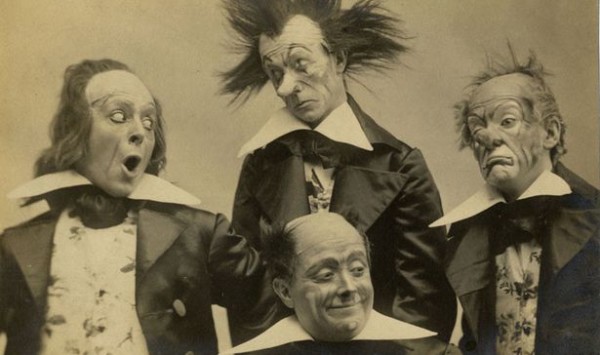
******************************************************************************************************************************* Brownstone Detectives investigates the history of our clients’ homes. The story you are about to read was composed from research conducted in the course of one of those investigations. Do you know the history of YOUR house? ******************************************************************************************************************************* Back in the early 1890s, in Stuyvesant Heights, there were clowns everywhere. Roaming and squeezing their little horns, making sad, droopy faces, and generally miming mischief. And everyone came to see them at Halsey Street and Saratoga where they paid a nickel a person to get in. Life for the clowns existed there for at least 20 years, until one day it all came to a halt. The developers had arrived and were threatening the home of the clown, threatening his very existence. BROOKLYN EXPANDS TO BUSHWICK By the mid-1890s, three blocks in the furthest reaches of the Eastern District’s Stuyvesant Heights had surprisingly remained untouched by speculative progress. While feverish land purchasing and selling had gone on all around this valuable real estate for the previous ten or so years, these dusty plots of land would continue to sit like the vestiges of the past that they were – unused farm land. Eventually, though, this land would be put to use by a bunch of clowns – the lots would begin, in 1891, to be referred to as the “circus grounds,” as traveling circuses and shows would begin annually to rent the land for their high profile extravaganzas. But the reign of the Stuyvesant Clown would be relatively short as, […]
THE COP, THE VIRUS, & THE PARROT (1930)
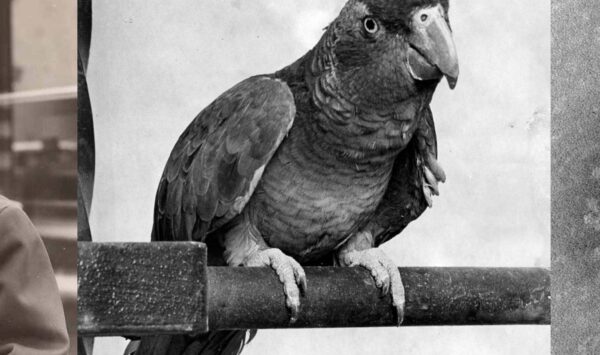
******************************************************************************************************************************** Brownstone Detectives investigates the history of our clients’ homes. The story you are about to read was composed from research conducted in the course of one of those investigations. Do you know the history of YOUR house? ******************************************************************************************************************************** One night in January of 1930, a recent NYPD Academy graduate, Officer Charles Suss, was patrolling his beat at Macon Street and Howard Avenue. “Six nights he has tramped his frosty beat in the cold hours between midnight and 8 a.m.,” the New York Times reported. “Six nights he has tramped his beat aimlessly, hoping for something to happen.” But then, as now, rookie cops got the worst time shifts. Also, Macon and Howard, according to the Times, was “a far removed section of Brooklyn” that was “apparently devoid of crimes. “There was only silence and a little rain.” But at 5 o’clock on that frosty January morning “Suss and his still brightly varnished stick swung down Howard Avenue. “The patrolman, as usual, was brooding on crime,” the Times claimed. “He had just decided that the girl he was rescuing would have light hair and blue eyes. In another moment they would be in the Marriage License Bureau at the Municipal Building.” But then came a “cry from the middle of Saratoga Park.” “Hello, Jake,” it cried. “Help! Help!” “Suss and his club streamed into the thin bushes of the park, guided by the racket and the calls for help. Suss remembered his undergraduate days and what he had been told […]
A BUILDER, A BRIBE, & A BLOCKED VIEW (1904)
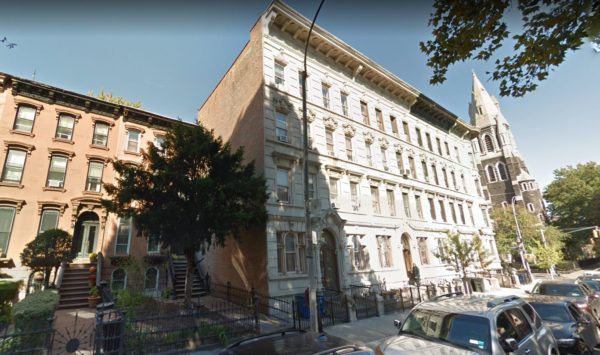
******************************************************************************************************************************** Brownstone Detectives investigates the history of our clients’ homes. The story you are about to read was composed from research conducted in the course of one of those investigations. Do you know the history of YOUR house? ******************************************************************************************************************************** After builder Chauncey G. Cozine had filed his building plans for a set of luxury apartment buildings to be constructed at the northwest corner of Throop Avenue and MacDonough Street, the neighbors were horrified to learn of the enormity of the structures. As a matter of fact, they were so taken aback at the prospect, that when they met to determine how to address the egregious assault on their homes, they dug deeply into their pockets – each of them as deep as he felt it was worth – to come up with a sum that, combined, would hopefully encourage Cozine to consider altering his designs. When Cozine received the offer, though, the 30-year-old builder answered the monetary plea with a curt one-word response. “No.” BEFORE THE FOUNDATIONS WERE EXCAVATED Before Cozine came along in 1904, the noble brownstone structures with their stately front gardens which sat along the north side of MacDonough Street, commanded unobstructed views up and down the street. From the front stoop of any of these structures, which belonged, incidentally, to some of the wealthiest residents of Stuyvesant Heights, could be seen rows of beautiful brownstone houses and the majestic churches of two different denominations. At the Tompkins end of the block, sat the Tomkins Avenue Congregational […]
THE EFFECTS OF WAR ON BED-STUY (1918)
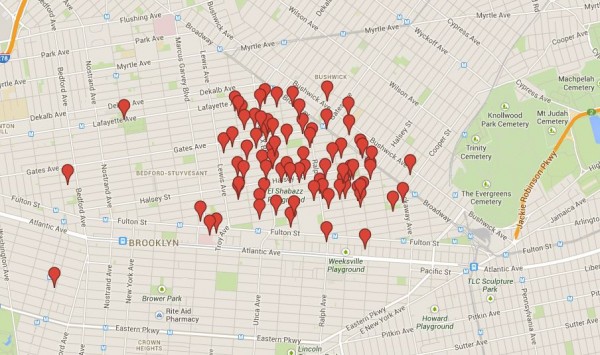
******************************************************************************************************************************** Brownstone Detectives investigates the history of our clients’ homes. The story you are about to read was composed from research conducted in the course of one of those investigations. Do you know the history of YOUR house? ******************************************************************************************************************************** During the brief period that the U.S. was engaged in WWI, the eastern section of Brooklyn’s Stuyvesant Heights section was decimated by its contribution of men to the war effort. Then, it was decimated a second time by the generous contribution it made of many of these mens’ lives. According to the honor rolls of the “Victory & Peace” memorial in Saratoga Park, approximately 105 men (and one woman) from the neighborhood made the ultimate sacrifice. There was a death on nearly every block of the district – often more. The MAP above shows with red pins the locations where some of these men lived – many of them who had left new wives, parents, and families waiting for them back home. The servicemembers, represented on this map by these red dots, never made it back home, though. Most were buried in American Cemeteries in France; some were re-buried here in the U.S. After the war, the Gold Star Mothers pilgrimages began to take place, as thousands of the mothers of these servicemembers made the government-sponsored trips to France in order to visit the last resting places of their children. Today, the specific memories of these citizens who grew up together, went to school together, played, learned, and competed together here […]
FINDING YOUR BROWNSTONE – IN 1924
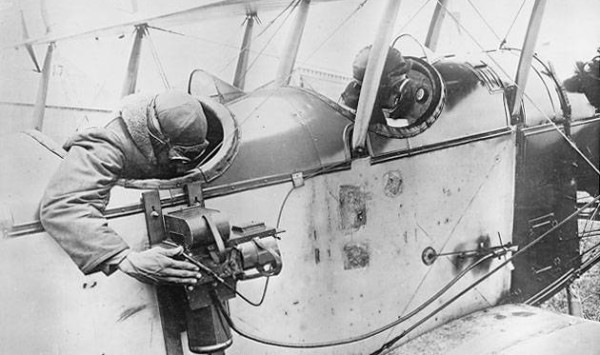
******************************************************************************************************************************** Brownstone Detectives investigates the history of our clients’ homes. The story you are about to read was composed from research conducted in the course of one of those investigations. Do you know the history of YOUR house? ******************************************************************************************************************************** Have you ever wondered what your neighborhood looked like in 1924? Or 1951? Or 1996? Aerial photography exists of all of New York City’s neighborhoods and is available to view (and zoom in on!) for free just by visiting NYC Map (a service of the City of New York). Simply type your address in the box at the top of the page and click “Search.” Then – in the upper right hand corner of the map – click on “Map Type,” and select the year you would like to view. Here is a view of Stuyvesant East in Bedford-Stuyvesant (showing Saratoga Park) in 1924. As you might have guessed, you won’t be able to see the expressions on peoples’ faces with this imagery, but it will give you a good indication of what your neighborhood looked like in any of these years. For comparison’s sake, here is a view of the same section of Bedford-Stuyvesant (as above) – but for 1996. What differences do you note between the two pictures? Comparing the two maps, you can see some obvious changes. Other than the fact that the second image is in color and was apparently taken in the winter time, if you look closely, you can see how whole swaths of brownstones […]